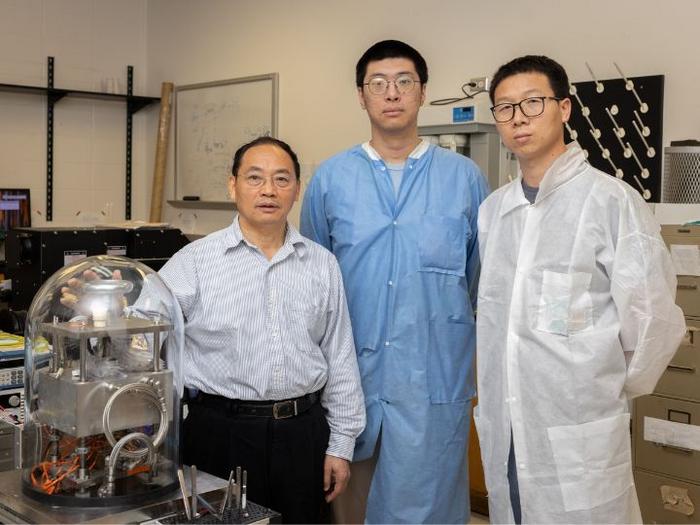HOUSTON, May 16, 2024 – Thermoelectric materials could play an important role in the clean energy transition, as they can produce electricity from sources of heat that would otherwise go to waste without generating additional greenhouse gases or requiring large up-front investment. But their promise has been slowed by the fact that most current thermoelectric materials don’t efficiently produce enough power to be useful for many practical applications.

Credit: Please give photo credit to University of Houston.
HOUSTON, May 16, 2024 – Thermoelectric materials could play an important role in the clean energy transition, as they can produce electricity from sources of heat that would otherwise go to waste without generating additional greenhouse gases or requiring large up-front investment. But their promise has been slowed by the fact that most current thermoelectric materials don’t efficiently produce enough power to be useful for many practical applications.
The search for new, more efficient materials involving complex chemical compositions has been labor-intensive, requiring experimental testing of each proposed new multi-material composition, and has often involved the use of toxic or rare elements. In a paper published Thursday, May 16, in the journal Science, researchers from the University of Houston and Rice University report a new approach to predict the realization of band convergence in a series of materials and, after demonstrating that one so-designed material, a p-type Zintl compound, would offer highly efficient thermoelectric performance, fabricated a thermoelectric module. They reported a heat-to-electricity conversion efficiency exceeding 10% at a temperature difference of 475 kelvin, or about 855 degrees Fahrenheit.
Zhifeng Ren, director of the Texas Center for Superconductivity at UH (TcSUH) and corresponding author for the paper, said the materials’ performance remained stable for more than two years.
While a variety of approaches have been used to improve efficiency, a concept known as electronic band convergence has gained attention for its potential to improve thermoelectric performance. “It is normally difficult to get high performance from thermoelectric materials because not all of the electronic bands in a material contribute,” Ren said. “It’s even more difficult to make a complex material where all of the bands work at the same time in order to get the best performance.”
For this work, he said, the scientists first focused on devising a calculation to determine how to build a material in which all the different energy bands can contribute to the overall performance. They then demonstrated that the calculation worked in practice as well as in theory, building a module to further verify the obtained high performance at the device level.
Band convergence is considered a good approach for improving thermoelectric materials because it increases the thermoelectric power factor, which is related to the actual output power of the thermoelectric module. But until now, discovering new materials with strong band convergence was time-consuming and resulted in many false starts. “The standard approach is trial and error,” said Ren, who is also the Paul C.W. Chu and May P. Chern Endowed Chair in Condensed Matter Physics at UH. “Instead of doing a lot of experiments, this method allows us to eliminate unnecessary possibilities that won’t give better results.”
To efficiently predict how to create the most effective material, the researchers used a high-entropy Zintl alloy, YbxCa1-xMgyZn2-ySb2, as a case study, designing a series of compositions through which band convergence was achieved simultaneously in all of the compositions.
Ren described how it works like this: If a team of 10 people try to lift an object, the taller members will carry most of the load while the shorter members do not contribute as much. In band convergence, the goal is to make all the band team members more similar – tall band members would be shorter, in this example, and short members taller – so all can contribute to carrying the overall load.
Here, the researchers started with four parent compounds containing five elements in total – ytterbium, calcium, magnesium, zinc and antimony – running calculations to determine which combinations of the parent compounds could reach band convergence. Once that was determined, they chose the best among these high-performance compositions to construct the thermoelectric device.
“Without this method, you would have to experiment and try all possibilities,” said Xin Shi, a UH graduate student in Ren’s group and lead author on the paper. “There’s no other way you can do that. Now, we do a calculation first, we design a material, and then make it and test it.”
The calculation method could be used for other multi-compound materials, too, allowing researchers to use this approach to create new thermoelectric materials. Once the proper parent compounds are identified, the calculation determines what ratio of each should be used in the final alloy.
In addition to Ren and Shi, the paper’s authors include Dr. Shaowei Song, a researcher at the Texas Center for Superconductivity, and Dr. Guanhui Gao from the Department of Materials Science and Nanoengineering at Rice. Gao is now at UH.
About the University of Houston
The University of Houston is a Carnegie-designated Tier One public research university recognized with a Phi Beta Kappa chapter for excellence in undergraduate education. UH serves the globally competitive Houston and Gulf Coast Region by providing world-class faculty, experiential learning and strategic industry partnerships. Located in the nation’s fourth-largest city and one of the most ethnically and culturally diverse regions in the country, UH is a federally designated Hispanic- and Asian-American-Serving institution with enrollment of more than 47,000 students.
Journal
Science
Article Title
Global band-convergence design for high-performance thermoelectric power generation in Zintls
Article Publication Date
16-May-2024



